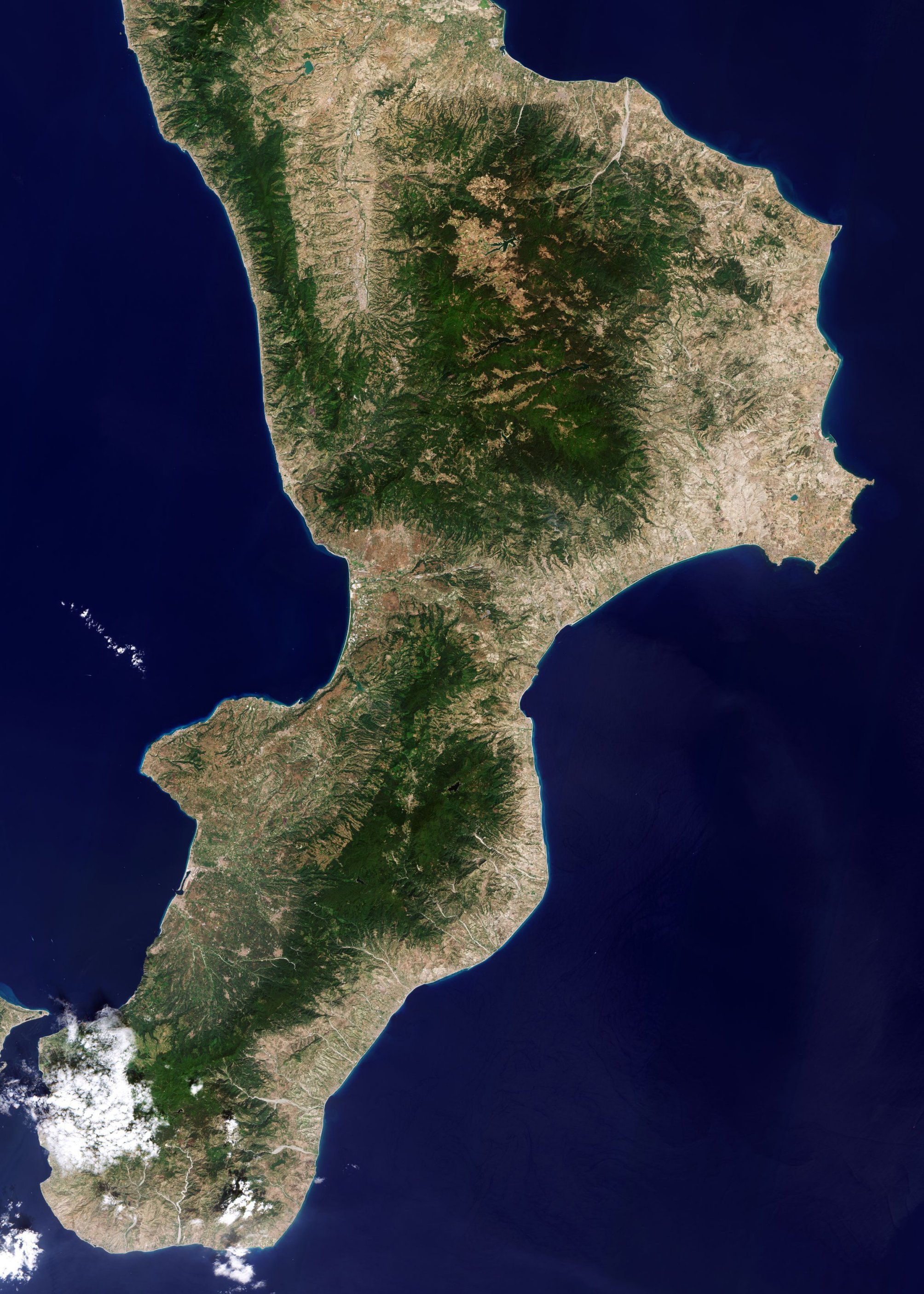La Calabria, spesso indicata come lo ‘stivale’ d’Italia, è mostrata in questa immagine catturata dalla missione Copernicus Sentinel-2.
La Calabria è una regione dell’Italia meridionale, famosa per il suo territorio irregolare, che si estende in direzione nord-sud per circa 250 km, separando il Mar Tirreno ad ovest dal Mar Ionio ad est. La regione copre un’area di circa 15 000 kmq (con oltre 740 km di costa) e di questa superficie circa il 49% è costituito da terreni agricoli.
Gran parte del suo territorio è montuoso o collinare, caratterizzato dalla presenza di tre complessi montuosi: il Pollino (non visibile), la Sila e l’Aspromonte.
La Sila è formata da un vasto altopiano montuoso a circa 1200 m sul livello del mare, che si estende per circa 2000 kmq lungo il settore centrale della Calabria. Il punto più alto è Botte Donato, che raggiunge circa 1928 m di altitudine.
Il massiccio dell’Aspromonte costituisce la punta più meridionale della penisola italiana, bagnato dal mare su tre lati. La cima più alta è Montalto, che raggiunge i 1955 m.
La Calabria è separata dalla Sicilia dallo Stretto di Messina, visibile in basso a sinistra, il cui punto più sottile - tra Capo Peloro in Sicilia e Punta Pezzo in Calabria - è di soli 3,2 km circa.
In Calabria risiedono quasi 2 milioni di persone e Reggio Calabria è la città più popolata della regione (con una popolazione stimata di circa 200 000 persone). La città sorge sul ‘piede’ della penisola italiana, lungo le pendici del complesso montuoso dell’Aspromonte.
La regione è conosciuta per il suo valore turistico e le sue principali attrazioni sono scogliere frastagliate e spiagge sabbiose. Tra queste destinazioni ci sono Tropea, Scilla, Lamezia Terme e Praia a Mare.
Così come è in grado di fornire dettagliate informazioni della vegetazione terrestre, la missione Copernicus Sentinel-2 è stata progettata anche per giocare un ruolo chiave nel mappare le differenze nella copertura del suolo, con l’obiettivo di conoscere il territorio, verificare il modo in cui viene utilizzato e monitorare i suoi cambiamenti nel corso del tempo.
Scarica immagine MediumRes (37,67 MB - .JPG)
Scarica immagine HighRes (139,73 MB - .TIF)
---
Calabria, Italy
Calabria, often referred to as the ‘boot’ of Italy, is featured in this image captured by the Copernicus Sentinel-2 mission.
Calabria is a region in southern Italy, famous for its irregular shape that stretches from north to south for around 250 km – separating the Tyrrhenian Sea to the west and the Ionian Sea to the east. The region covers an area of around 15 000 sq km (with over 740 km of coastline) of which agricultural land covers 49%.
Most of the region is mountainous or hilly with three mountain ranges present: Pollino (not visible), La Sila and Aspromonte.
La Sila is a vast mountainous plateau around 1200 m above sea level, stretching for nearly 2000 sq km along the central area of Calabria. The highest point is Botte Donato, which reaches around 1928 m.
The Aspromonte massif forms the southernmost tip of the Italian peninsula bordered by the sea on three sides. The highest peak is Montalto at 1955 m.
Calabria is separated from Sicily by the Strait of Messina, visible in the bottom-left, where the narrowest point between Capo Peloro in Sicily and Punta Pezzo in Calabria is only around 3.2 km.
Almost 2 million people reside in Calabria, with Reggio Calabria being the most populous city in the region (with an estimated population of around 200 000 people). The city lies on the ‘toe’ of the Italian Peninsula, on the slopes of the Aspromonte mountain range.
Calabria is known for its tourism, with its main attractions being the rugged cliffs and sandy beaches. Some of these main destinations include Tropea, Scilla, Lamezia Terme and Praia a Mare.
As well as providing detailed information about Earth’s vegetation, the Copernicus Sentinel-2 mission is designed to play a key role in mapping differences in land cover to understand the landscape, map how it is used and monitor changes over time.
(Fonte: ESA - Image of the week: "Calabria, Italy". Traduzione: Gianluca Pititto)
Copia qui lo "short link" a questo articolo
www.geoforall.it/{sh404sef_shurl}




